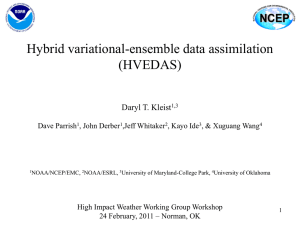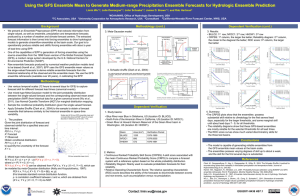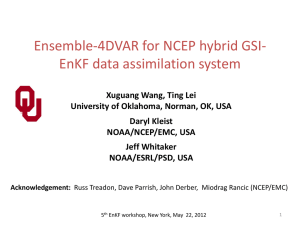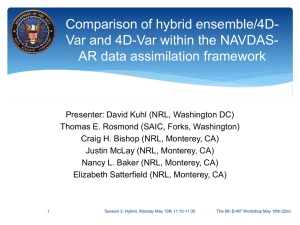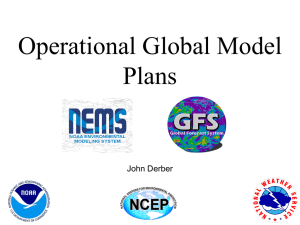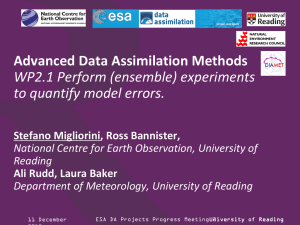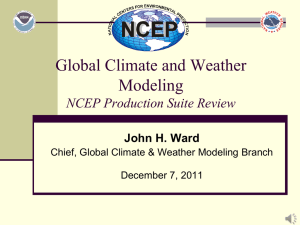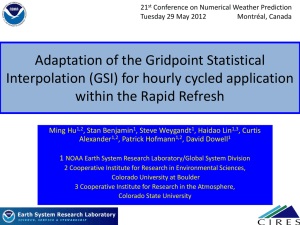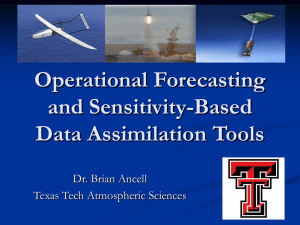Hybrid ensemble-Var data assimilation - PSU WRF/EnKF Real-time
advertisement
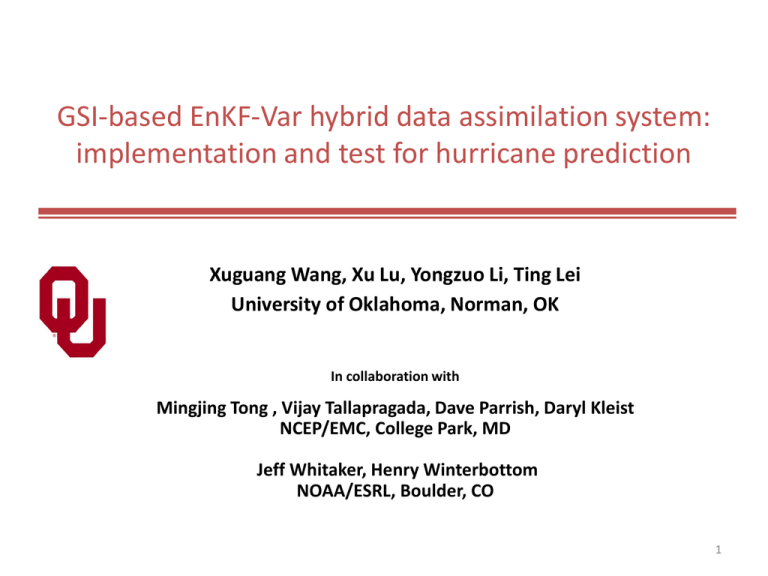
GSI-based EnKF-Var hybrid data assimilation system: implementation and test for hurricane prediction Xuguang Wang, Xu Lu, Yongzuo Li, Ting Lei University of Oklahoma, Norman, OK In collaboration with Mingjing Tong , Vijay Tallapragada, Dave Parrish, Daryl Kleist NCEP/EMC, College Park, MD Jeff Whitaker, Henry Winterbottom NOAA/ESRL, Boulder, CO 1 GSI-based Hybrid EnKF-Var DA system Wang, Parrish, Kleist, Whitaker 2013, MWR EnKF Whitaker et al. 2008, MWR EnKF analysis 2 member 2 forecast member k forecast control forecast Ensemble covariance GSI-ACV Wang 2010, MWR data assimilation EnKF analysis k control analysis Re-center EnKF analysis ensemble to control analysis EnKF analysis 1 member 1 forecast member 1 analysis member 1 forecast member 2 analysis member 2 forecast member k analysis member k forecast control forecast First guess forecast 2 GSI hybrid for GFS: GSI 3DVar vs. 3DEnsVar Hybrid vs. EnKF 3DEnsVar Hybrid was better than 3DVar due to use of flow-dependent ensemble covariance 3DEnsVar was better than EnKF due to the use of tangent linear normal mode balance constraint Wang, Parrish, Kleist and Whitaker, MWR, 2013 3 GSI hybrid for GFS: 3DEnsVar vs. 4DEnsVar • GSI-4DEnsVar: Naturally extended from and unified with GSIbased 3DEnsVar hybrid formula (Wang and Lei, 2014, MWR, in press). Add time dimension in 4DEnsVar J x1' , α 1 J1 2 J e J o 1 T 1 1 T 1 1 x1' B static x1' 2 αT C1α t 1 ( yto '-Ht xt ) T R -t1 ( yto '-Ht xt ) 2 2 2 K xt x α k (x ek )t ' ' 1 k 1 B stat 3DVAR static covariance; R observation error covariance; K ensemble size; C correlation matrix for ensemble covariance localization; xek kth ensemble perturbation; x1' 3DVAR increment; x ' total (hybrid) increment; y o ' innovation vector; H linearized observation operator; 1 weighting coefficient for static covariance; 2 weighting coefficient for ensemble covariance; α extended control variable. 4 GSI hybrid for GFS: 3DEnsVar vs. 4DEnsVar Results from Single Reso. Experiments 4DEnsVar improved general global forecasts 4DEnsVar improved the balance of the analysis Performance of 4DEnsVar degraded if less frequent ensemble perturbations used 4DEnsVar approximates nonlinear propagation better with more frequent ensemble perturbations TLNMC improved global forecasts Wang, X. and T. Lei, 2014: GSI-based four dimensional ensemble-variational (4DEnsVar) data assimilation: formulation and single resolution experiments with real data for NCEP Global Forecast System. Mon. Wea. Rev., in press. 5 GSI hybrid for GFS: 3DEnsVar vs. 4DEnsVar 16 named storms in Atlantic and Pacific basins during 2010 6 Approximation to nonlinear propagation –3h increment propagated by model integration 4DEnsVar (hrly pert.) 4DEnsVar (2hrly pert.) 3DEnsVar Hurricane Daniel 2010 * -3h time 0 3h 7 Verification of hurricane track forecasts • • • • 3DEnsVar outperforms GSI3DVar. 4DEnsVar is more accurate than 3DEnsVar after the 1-day forecast lead time. Negative impact if using less number of time levels of ensemble perturbations. Negative impact of TLNMC on TC track forecasts. 8 Development and research of GSI based Var/EnKF/hybrid for regional modeling system GSI-based Var/EnKF/3D4DHybrid GFS WRF-NMMB WRF ARW HurricaneWRF (HWRF) Poster: Johnson et al. “Development and Research of GSI based Var/EnKF/hybrid Data Assimilation for Convective Scale Weather Forecast over CONUS.” 9 GSI hybrid for HWRF Hurricane Sandy, Oct. 2012 Complicated evolution Tremendous size 147 direct deaths across Atlantic Basin US damage $50 billion New York State before and after nhc.noaa.gov 10 Experiment Design • Model: HWRF Sandy 2012 •Observations: radial velocity from Tail Doppler Radar (TDR) onboard NOAA P3 aircraft • Initial and LBC ensemble: GFS global hybrid DA system • Ensemble size: 40 11 Experiment Design • Model: HWRF Oper. HWRF •Observations: radial velocity from Tail Doppler Radar (TDR) onboard NOAA P3 aircraft • Initial and LBC ensemble: GFS global hybrid DA system • Ensemble size: 40 12 TDR data distribution (mission 1) P3 Mission 1 13 Verification against SFMR wind speed Last Leg 14 Comparison with HRD radar wind analysis 15 Comparison with HRD radar wind analysis S N 16 Track forecast (RMSE for 7 missions) 17 Experiments for 2012-2013 seasons Correlation between HRD radar wind analysis and analyses from various DA methods 0.9 0.8 0.7 0.6 0.5 0.4 0.3 0.2 0.1 0 1 2 3 4 5 Hybrid 6 7 8 9 10 11 12 13 14 15 16 17 18 19 20 21 22 GSI3DVAR Case# Hybrid-GFSENS 18 ISSAC 2012 (mission 7) 19 Verification against SFMR and flight level data Experiments for 2012-2013 season Track MSLP 21 Two-way Dual Resolution Hybrid for HWRF 9km •3km movable nest ingests 9km HWRF EnKF ensemble •Two-way coupling 3km •Tests with IRENE 2011 assimilating airborne radar data 22 Two-way Dual resolution hybrid Summary and ongoing work GFS a. GSI-based 4DEnsVar for GFS improved global forecast and TC forecast. b. The analysis generated by 4DEnsVar was more balanced than 3DEnsVar. c. the performance of 4DEnsVar was in general degraded when less frequent ensemble perturbations were used. d. The tangent linear normal mode constraint had positive impact for global forecast but negative impact for TC track forecasts. e. Preliminary tests showed positive impact of the temporal localization on the performance of 4DEnsVar. HWRF a. The GSI-based hybrid EnKF-Var data assimilation system was expanded to HWRF. b. Various diagnostics and verifications suggested this unified GSI hybrid DA system provided more skillful TC analysis and forecasts than GSI 3DVar and than HWRF GSI hybrid ingesting GFS ensemble. c. Airborne radar data improved TC structure analysis and forecast, TC track and intensity forecasts. Impact of the data depends on DA methods. d. Dual-resolution (3km-9km) two way hybrid for HWRF showed promising results. e. Developing/enhancing 4DEnsVar hybrid and assimilation of other airborne data 24 and other data from NCEP operational data stream for HWRF. Development and Research of GSI-based Var/EnKF/hybrid DA for Convective Scale Weather Forecasts over CONUS Poster: Johnson, Wang, Lei, Carley, Wicker, Yussouf, Karstens • Outer Domain – assimilate operational conventional surface and mesonet observations, RAOB, wind profiler, ACARS, and satellite derived winds every 3 hours to define synoptic/mesoscale environment • Inner Domain – assimilate velocity and reflectivity from NEXRAD radar network every 5 min during last 3hr cycle 4 km 12 km Johnson, Wang et al. 2014 25 Precipitation forecast skill averaged over 10 complex, convectively active cases • GSI-EnKF forecasts are more skillful than GSI-3DVar forecasts for all thresholds and lead times. • Benefits of radar data are more pronounced assimilated by GSI-EnKF than GSI-3DVar. 26 May 8th 2003 OKC Tornadic Supercell 1hr forecast from 22Z GSI hybrid GSI hybrid Ref and vorticity at 1 km Lei, Wang et al. 2014 W and Vort. at 4 km 27 DA cycling configuration (mission 1) Cold Start GSI3DVar OBS Spin-up Forecast Deterministic Forecast DA Cycle OBS Hybrid Spin-up Forecast Deterministic Forecast Ensemble Perturbation OBS HWRF EnKF Deterministic Forecast Ensemble Spin-up Forecast DA Cycle 28 DA cycling configuration (mission 1) OBS Hybrid-GFSENS Spin-up Forecast Deterministic Forecast Ensemble Perturbation GFS ENS 29 GSI-based Hybrid EnKF-Var DA system • • (4D)EnKF: ensemble square root filter interfaced with GSI observation operator (Whitaker et al. 2008) GSI-3DEnsVar: Extended control variable (ECV) method implemented within GSI variational minimization (Wang 2010, MWR): J x1' , α 1 J1 2 J e J o 1 ' T 1 ' 1 T 1 1 o' ' T 1 x1 B x1 2 α C α y Hx R 1 y o ' Hx' 2 2 2 K x x α k x ek ' ' 1 k 1 Extra term associated with extended control variable Extra increment associated with ensemble 30
